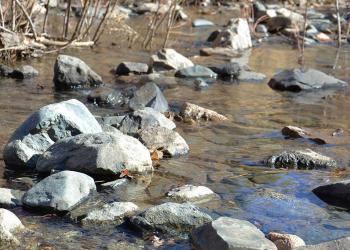Natural Resources
National Forest lands are owned by the American public and are managed for multiple uses that deliver social, economic, and environmental benefits: clean water, fish and wildlife, range, timber, minerals, and recreation. There are also “special uses” of forest lands that benefit society as a whole. Specialists and technicians employed by Prescott National Forest aim to manage all uses such that future generations can continue to reap the benefits of our treasured landscapes and waterways.
Clean Water

The Prescott Forest Reserve, what is now Prescott National Forest, was set aside in 1898 to protect water sources for area communities--a critical effort that continues to this day. The quality of the water, air and soil contribute to the health of the forest and the plants and animals that live here.
Grassland Health

Rangeland managers focus on maintaining productive rangelands into the future that can sustain livestock production for society while also providing for wildlife habitat, sources of clean water, and recreational opportunities.
Focus on Forest Health

Before the Forest Preserve was set aside in 1898, unregulated logging, mining, grazing, hunting, and recreation dramatically changed the forest from its natural state. This was also when a policy of suppressing ALL fires resulted in unhealthy, overgrown forests. Today, natural resource managers seek to protect nature’s benefits for current and future generations by restoring health to forests, grasslands, and waterways.
Archeology & Cultural Resources

The Desert Southwest holds an extraordinary record of the past. Numerous federal and state parks, historical societies, and museums adjacent to Prescott National Forest attract students and visitors from around the globe to experience first-hand the long-time use of this area by humans.
Minerals

Discovery of gold in the mineral-rich Bradshaw Mountains in 1863, followed by discoveries of copper and silver, sparked an influx of newcomers. Today, working mines produce minerals including cement, flagstone, and precious metals for jewelry and for manufacturing electronics. Recreationists enjoy rockhounding and panning for gold.
Special Uses

National Forest lands are owned by the American public and are managed for multiple uses that deliver social, economic, and environmental benefits: clean water, fish and wildlife, range, timber, minerals, and recreation. There are also “special uses” of forest lands that benefit society as a whole.
Recreation: The Pursuit of Happiness

Central Arizona’s mild climate allows for year-round outdoor recreation which provides physical, emotional, economic, and spiritual benefits to people and society.
Benefits of Recreation
Healthy societies need healthy people. Fresh air and exercise promote physical health which in turn contributes to life satisfaction. Mastering new skills and tackling challenges boosts self-esteem. Shared recreational experiences strengthen family bonds and deepen friendships. Most developed recreation facilities on the Forest are accessible to wheelchairs and can be enjoyed by anyone!
Breath-taking scenery, starry nights, and abundant recreational opportunities draw a multitude of visitors to central Arizona —and make it a great place to call home! Outdoor recreation fuels demand for goods and services including sporting goods, outfitter-guides, food and lodging, and transportation. Recreation-related businesses are a major source of local employment, and real estate values increase with proximity to public lands. House hunters and businesses seeking to relocate covet the quality of life in the area with its natural setting, open space, and convenience to outdoor recreation.
Spending time in Nature can inspire its stewardship. WILDERNESS is designated by Congress as “an area of undeveloped Federal land retaining its primeval character and influence.” Wilderness is a repository of clean air and water, unfragmented wildlife habitat, and natural areas for research and education. The forest’s eight wilderness areas are ideal places to view wildlife, hike, ride horses, backpack, find solitude, and connect with Nature. Part of the Verde River has WILD & SCENIC RIVER status protecting its outstanding natural, cultural, and recreational values.



